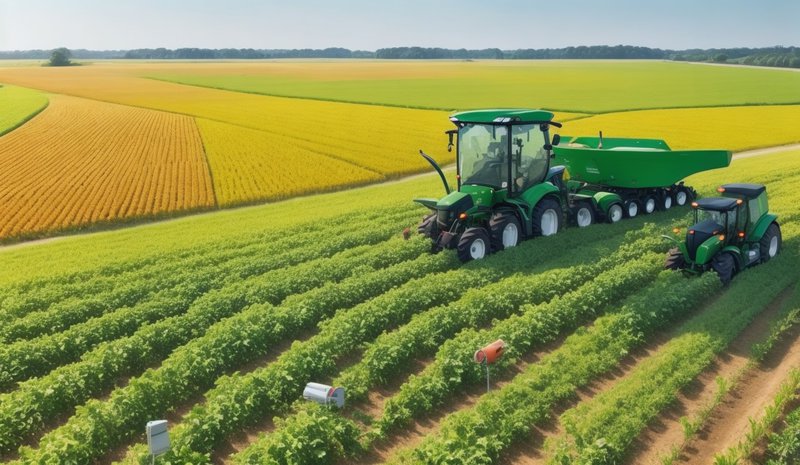Can IoT Enable Smart Agriculture and Precision Farming

Are you curious about how IoT can revolutionize smart agriculture and precision farming? Look no further!
In this article, we will explore the role of IoT in enhancing agricultural practices and maximizing crop yield. Discover the benefits of implementing IoT solutions for crop monitoring, livestock health tracking, and precision irrigation techniques.
Join us as we delve into the world of IoT and uncover its potential to transform the agricultural industry.
Key Takeaways
- IoT technology allows farmers to collect and analyze data from various sensors placed in different parts of their farms.
- Real-time data enables farmers to make informed decisions about irrigation, fertilization, and pest control.
- IoT integration increases yields, reduces water and fertilizer usage, and minimizes pesticide use.
- Farmers achieve higher productivity, lower costs, and more sustainable practices.
The Role of IoT in Smart Agriculture
You might be wondering how IoT plays a role in smart agriculture and precision farming. Well, the answer lies in the role of sensors in smart agriculture.
IoT technology enables farmers to collect and analyze data from various sensors placed in different parts of their farms. These sensors monitor crucial factors such as soil moisture, temperature, humidity, and even crop growth. With this real-time data, farmers can make informed decisions about irrigation, fertilization, and pest control, ensuring optimal conditions for their crops.
The impact of IoT on farming practices is immense. It allows farmers to increase their yields, reduce water and fertilizer usage, and minimize the use of pesticides. By integrating IoT into their farming operations, farmers can achieve higher productivity, lower costs, and more sustainable practices.
Benefits of Implementing IoT in Precision Farming
When it comes to precision farming, implementing IoT can offer you a range of benefits.
One key advantage is the potential for increased crop yield. With IoT-enabled sensors and devices, you can closely monitor and analyze various factors that affect crop growth, enabling you to make data-driven decisions that optimize yield.
Additionally, IoT provides real-time monitoring capabilities, allowing you to remotely track and manage crucial aspects such as soil moisture levels, temperature, and pest infestation, ensuring prompt action and efficient resource allocation.
Increased Crop Yield
By implementing IoT in your agricultural practices, you’ll be able to achieve increased crop yield through precise monitoring and data-driven decision making. Here’s how IoT can help you maximize your agricultural output:
- Real-time monitoring: IoT sensors can provide you with real-time data on soil moisture levels, temperature, and weather conditions. This information allows you to make timely decisions regarding irrigation, fertilization, and pest control.
- Precision irrigation: IoT-enabled irrigation systems can deliver water directly to the roots of plants based on their specific needs. This not only saves water but also ensures that crops receive the right amount of moisture for optimal growth.
- Automated pest control: IoT devices can track pest activity and alert you when intervention is required. This helps you take proactive measures to protect your crops, minimizing damage and maximizing production.
- Smart harvesting: IoT technology can help you optimize the timing of harvest by monitoring crop maturity and weather conditions. This ensures that you harvest your crops at the peak of their nutritional value and market demand.
With IoT, you can revolutionize your agricultural practices and achieve increased crop yield, ultimately maximizing your agricultural output.
Real-Time Monitoring Capabilities
With real-time monitoring capabilities, you can make data-driven decisions for optimal crop growth and yield. Through remote sensing and data analytics, you can gather valuable information about your crops and their environment.
By using sensors and drones equipped with cameras, you can monitor various aspects such as soil moisture, temperature, and nutrient levels. This data can then be analyzed using advanced algorithms to provide insights on when to irrigate, fertilize, or apply pesticides.
By taking advantage of real-time monitoring, you can detect early signs of plant stress or disease and take immediate action to mitigate potential damage. Additionally, by continuously monitoring your crops, you can identify patterns and trends over time, enabling you to make informed decisions for future planting seasons.
Real-time monitoring capabilities empower you to optimize your farming practices and achieve higher crop yields.
IoT Solutions for Crop Monitoring and Management
You can use IoT solutions for crop monitoring and management in smart agriculture and precision farming. With the help of IoT, you can implement efficient pest control measures to protect your crops.
By utilizing sensors for soil analysis, you can gather real-time data on soil conditions, such as moisture levels and nutrient content. This information allows you to optimize irrigation and fertilization processes, ensuring that your crops receive the necessary nutrients and water for healthy growth.
IoT solutions also enable you to monitor environmental factors like temperature and humidity, which play a crucial role in crop development. By having access to this data, you can make informed decisions and take preventive measures to protect your crops from adverse weather conditions and potential diseases.
Overall, IoT solutions provide valuable insights and control in managing your crops effectively and efficiently.
Leveraging IoT for Livestock Monitoring and Health Tracking
Leveraging IoT technology allows you to monitor the health and track the well-being of your livestock more effectively.
IoT applications in soil analysis can provide you with valuable information about the quality of your land, enabling you to make informed decisions about grazing and fertilization.
By using IoT solutions for pest control, you can receive real-time alerts about potential threats to your livestock, such as the presence of harmful insects or predators. These solutions can help you take immediate action to protect your animals and prevent any potential damage.
With IoT devices and sensors attached to your livestock, you can continuously monitor their vital signs, such as body temperature and heart rate, allowing you to detect any signs of illness or distress early on.
This proactive approach to livestock monitoring can significantly improve their overall health and well-being.
Precision Irrigation Techniques Enabled by IoT
In this discussion, you’ll explore the exciting possibilities of water-saving IoT solutions and their potential to enhance crop yield.
With the help of IoT technology, you can implement precision irrigation techniques that optimize water usage and reduce waste.
Water-Saving Iot Solutions
Water-saving IoT solutions can greatly improve the efficiency of irrigation systems in smart agriculture and precision farming. Here are four ways these solutions can benefit you:
- Smart irrigation: IoT technology enables real-time monitoring of soil moisture levels, weather conditions, and plant water requirements. This data allows for precise and timely irrigation, reducing water waste.
- Automated control: With IoT-enabled systems, you can remotely control and automate irrigation processes based on predefined parameters. This reduces the need for manual intervention and ensures optimal water usage.
- Leak detection: IoT sensors can detect leaks in irrigation systems, preventing water loss and potential damage to crops. Early detection allows for quick repairs, minimizing water wastage.
- IoT-enabled greenhouses: These advanced structures use sensors and automation to optimize water usage. They can adjust humidity levels, monitor plant health, and deliver precise amounts of water, resulting in significant water savings.
Enhanced Crop Yield Potential
Using advanced technology, you can maximize your crop yield potential through enhanced monitoring and optimized growing conditions. By implementing IoT solutions, such as sensors and data analytics, you can increase productivity on your farm.
These smart devices can monitor various factors like soil moisture, temperature, and nutrient levels, providing you with real-time data. With this information, you can make informed decisions about when to water, fertilize, or protect your crops from pests and diseases.
Additionally, by analyzing historical data and weather forecasts, you can optimize your farming practices, ensuring that your crops receive the ideal conditions for growth. This precision farming approach not only saves you time and resources but also allows you to achieve higher crop yields and ultimately improve your overall profitability.
Enhancing Crop Yield and Quality With Iot in Agriculture
By utilizing IoT technology, you can improve crop yield and quality in smart agriculture. Here’s how:
- Smart Sensors: With the help of smart sensors embedded in the fields, you can monitor and collect real-time data on various parameters like soil moisture, temperature, and nutrient levels. This data can be crucial in making informed decisions regarding irrigation, fertilization, and pest control.
- Data Analytics: By analyzing the data collected from the smart sensors, you can gain valuable insights into crop health, growth patterns, and potential risks. This information can help you optimize your farming practices, identify areas of improvement, and take proactive measures to prevent crop diseases and yield losses.
- Precision Farming: Armed with accurate and timely data, you can implement precision farming techniques. This involves using precise amounts of water, fertilizers, and pesticides based on the specific needs of each crop, resulting in optimal resource utilization and improved crop productivity.
- Enhanced Quality Control: IoT technology can enable you to monitor the quality of your crops throughout the cultivation process. By tracking factors like temperature, humidity, and storage conditions, you can ensure that your produce meets the desired quality standards, leading to increased market value and customer satisfaction.
Overcoming Challenges in Adopting IoT for Smart Agriculture
To overcome challenges in adopting IoT for smart agriculture, you’ll need to address issues such as limited connectivity, high initial investment, and lack of technical expertise. These challenges can hinder the implementation of IoT in agriculture and prevent farmers from fully harnessing its benefits. Limited connectivity can restrict the flow of data between devices, affecting real-time monitoring and control of farming operations. High initial investment may deter farmers from investing in IoT infrastructure and devices. Additionally, the lack of technical expertise can make it difficult for farmers to effectively manage and maintain IoT systems. Furthermore, data security concerns are a major challenge in IoT implementation, as the collection and storage of sensitive agricultural data can be vulnerable to cyber attacks.
| Challenges in IoT Implementation | Data Security Concerns |
|---|---|
| Limited connectivity | Cyber attacks |
| High initial investment | Data breaches |
| Lack of technical expertise | Unauthorized access |
| Privacy concerns |
Frequently Asked Questions
What Are the Potential Economic Benefits of Implementing Iot in Precision Farming?
IoT’s impact on precision farming includes exploring the potential economic benefits. By improving crop yield and quality, IoT enables farmers to increase profits and optimize resource usage, leading to a more sustainable agricultural industry.
How Can Iot Solutions for Crop Monitoring and Management Improve the Overall Efficiency of Agricultural Operations?
By implementing IoT solutions for crop monitoring and management, you can improve the overall efficiency of your agricultural operations. Real-time data analysis allows for better decision-making and crop yield optimization.
What Are the Key Factors to Consider When Leveraging Iot for Livestock Monitoring and Health Tracking?
When leveraging IoT for livestock monitoring and health tracking, consider key factors like improving livestock productivity and enabling disease prevention through IoT technology.
How Can Precision Irrigation Techniques Enabled by Iot Help Conserve Water Resources in Agriculture?
Drones for surveillance and soil moisture sensors are two key elements of precision irrigation techniques enabled by IoT. They help conserve water resources in agriculture by providing real-time data and allowing for optimized watering schedules.
What Are Some Examples of How Iot Can Enhance Crop Yield and Quality in Agriculture?
IoT can enhance crop yield and quality in agriculture through its applications in enhancing soil fertility and enabling pest control methods. Embrace IoT’s potential to optimize your farming practices and maximize your harvests.







